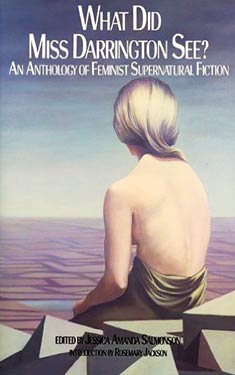Jessica Amanda Salmonson, ed.
Completed 11/13/2016 Reviewed 11/14/2016
5 stars
This is an anthology of feminist supernatural short stories
written between 1850 and 1989. Almost
all the stories have a ghost, but none are truly horror stories. At least not like how we consider horror
today. They are just mostly ghost
stories with the most common theme of women trying to be authentic. None of the stories are man-hating, although
one of the stories has a man who is rather a cad. They are almost all simply about fulfillment
in a woman’s life, or the lack thereof, and that issue brought forth by the
appearance of a ghost.
 Many of the older stories are classical gothic
story-telling. A few are magical
realism. Several deal with lesbian
relationships, or at the very least have homoerotic overtones. Some of these in the older stories feature
what was known as Boston marriages, relationships between two women who lived together
without the support of a man. The
relationships were not always sexual, but in these stories, the implication
that they were is pretty evident.
Many of the older stories are classical gothic
story-telling. A few are magical
realism. Several deal with lesbian
relationships, or at the very least have homoerotic overtones. Some of these in the older stories feature
what was known as Boston marriages, relationships between two women who lived together
without the support of a man. The
relationships were not always sexual, but in these stories, the implication
that they were is pretty evident.
I really enjoyed most of the stories. I found them quite emotionally engaging
without being maudlin or soapy. There
were only a few I didn’t care for. One,
“The Teacher” was about a man who goes back to visit an old school teacher who
barely remembers him. Another, “Pandora
Pandemonia” was a short piece mostly filled with classical imagery. I didn’t get either of these stories.
Two pieces really stood out for me. One was “The Little, Dirty Girl” by Joanna
Russ. I was surprised by this piece
because I’ve only read novels of Russ, and they are Science Fiction and very
avant-garde. I found her novels
difficult to understand, but this story was not only understandable, but very
touching. It’s about a woman who sees a
little girl wearing a dirty out-of-date dress.
The girl follows the woman around and the woman eventually begins to
take care of the girl. It soon becomes
evident that the little girl is a ghost although she manifests quite
physically. It also becomes clear that
the girl represents the woman’s inner child and helps her reconcile her own
mother-issues.
The second piece I really liked was “The Doll”. It’s about a woman who becomes obsessed with
a life-sized representation of the former mistress of a castle. This is one of those stories with homoerotic
overtones. The editor does a great job
of providing introductions to each story.
These intros are really helpful in inspiring thoughts and questions
about the stories. Particularly, it made
me wonder if this is really about suppression of homoerotic feelings, or about
closure in obsessive relationships.
A third story I wanted to mention is “A Friend In
Need”. It’s a relatively newer story
about two women who discover they were each other’s imaginary friends growing
up. It explores what we sometimes will
do to get through abusive childhoods.
This story was imaginative and emotionally gripping.
I give this book five out of five stars. It’s the first book in a long time to which I
had an emotional response. I started out
appreciating it academically, but then with each story, it drew me farther and
farther in, so that by the last story, I was simply captivated. I don’t expect everyone to have the same
response to this book. The stories are a
lot more subtle than what we’re used to.
But if you’re up for a subtle set of stories written by women about
women, then I highly recommend this anthology.
No comments:
Post a Comment